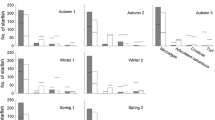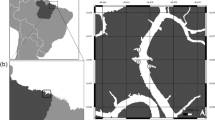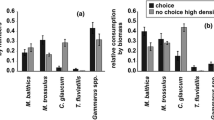Abstract
Understanding the impact of environmental stressors on predator activity is a prerequisite to understanding the underlying mechanisms shaping community structure. The nemertean Prosorhochmus nelsoni is a common predator in the mid-intertidal zone on rocky shores along the Chilean coast, where it can reach very high abundances (up to 260 ind m−2) in algal turfs, algal crusts, barnacle crusts, and mixed substrata. Tidal and diurnal scans revealed that the activity of P. nelsoni is primarily restricted to night and early-morning low tides and is relatively low when air temperatures are high. On average, larger worms crawled faster than smaller worms, with their maximum velocity being influenced by substratum type. Their estimated rate of predation is 0.092 prey items nemertean−1 day−1, just below the laboratory rate of ~0.2 amphipods nemertean−1 day−1 previously estimated for this species. P. nelsoni consumes a diverse spectrum of prey items (i.e., amphipods, isopods, decapods, barnacles, and dipterans) and is possibly exerting a significant influence on its prey populations. We suggest that the opportunistic predatory behavior of this intertidal predator is caused by the trade-off between immediate persistence (e.g., avoidance of desiccation) and long-term survival through successful foraging.





Similar content being viewed by others
References
Abrams PA (1993) Why predation rate should not be proportional to predator density. Ecology 74:726–733
Ambrose WG (1991) Are infaunal predators important in structuring marine soft-bottom communities? Am Zool 31:849–860
Amerongen HM, Chia FS (1982) Behavioural evidence for a chemoreceptive function of the cerebral organs in Paranemertes peregrina Coe (Hoplonemertea: Monostilifera). J Exp Mar Biol Ecol 64:11–16
Bourque D, Miron G, Landry T (2002) Predator-prey relationship between the nemertean Cerebratulus lacteus and the soft-shell clam, Mya arenaria: surface-exploration activity and qualitative observations on feeding behavior. Can J Zool 80:1204–1211
Burnham KP, Anderson DR (2002) Model selection and multi-model inference. Springer Verlag, New York
Caplins SA, Turbeville JM (2011) Feeding rates on the nemertean Prosorhochmus americanus (Hoplonemertea) on two species of gammaridean amphipods. Invertebr Biol 130:34–42
Christy JH, Goshima S, Backwell PRY, Kreuter TJ (1998) Nemertean predation on the tropical fiddler crab Uca musica. Hydrobiologia 365:233–239
Connell JH (1970) A predator-prey system in the marine intertidal region. I. Balanus glandula and several predatory species of Thais. Ecol Monogr 40:49–78
Dayton PK (1971) Competition, disturbance, and community organization: the provision and subsequent utilization of space in a rocky intertidal community. Ecol Monogr 41:351–389
Forward RB, Bourla MH, Darnell MZ, Cohen JH (2009) Entrainment of the circadian rhythm of the supratidal amphipod Talorchestia longicornis by light and temperature: mechanisms of detection and hierarchical organization. Mar Freshw Behav Physiol 42:233–247
Gaymer CF, Dutil C, Himmelman JH (2004) Prey selection and predatory impact of four major sea stars on a soft bottom subtidal community. J Exp Mar Biol Ecol 313:353–374
Huey RB, Pianka ER (1981) Ecological consequences of foraging mode. Ecology 62:991–999
Kem WR (1985) Structure and action of nemertine toxins. Am Zool 25:99–111
Kruse I, Buhs F (2000) Preying at the edge of the sea: the nemertine Tetrastemma melanocephalum and its amphipod prey on high intertidal sandflats. Hydrobiologia 426:43–55
McDermott JJ (1976) Predation of the razor clam Ensis directus by the nemertean worm Cerebratulus lacteus. Chesapeake Sci 17:299–301
McDermott JJ (1984) The feeding biology of Nipponnemertes pulcher (Johnston) (Hoplonemertea), with some ecological implications. Ophelia 23:1–21
McDermott JJ (1998) Observations on feeding in a South African suctorial hoplonemertean, Nipponnemertes sp. (Family Cratenemertidae). Hydrobiologia 365:251–256
McDermott JJ, Roe P (1985) Food, feeding behavior and feeding ecology of nemerteans. Am Zool 25:113–125
Menge BA, Sutherland JP (1976) Species diversity gradients: synthesis of the roles of predation, competition, and temporal heterogeneity. Am Nat 110:351–369
Menge BA, Sutherland JP (1987) Community regulation: variation in disturbance, competition, and predation in relation to environmental stress and recruitment. Am Nat 130:730–757
Monaco CJ, Helmuth B (2011) Tipping points, thresholds and the keystone role of physiology in marine climate change research. Adv Mar Biol 60:123–160
Nordhausen W (1988) Impact of the nemertean Lineus viridis on its polychaete prey on an intertidal sandflat. Hydrobiologia 156:39–46
Perry G, Pianka ER (1997) Animal foraging: past, present and future. Tree 12:360–364
Quinn GP, Keough MJ (2002) Experimental design and data analysis for biologists. Cambridge University Press, Cambridge
R Development Core Team (2011) R: a language and environment for statistical computing. Version 2.13.0. R Foundation for Statistical Computing, Vienna
Rochette R, Hamel J, Himmelman JH (1994) Foraging strategy of the asteroid Leptasterias polaris: role of prey odors, current and feeding status. Mar Ecol Prog Ser 106:93–100
Roe P (1970) The nutrition of Paranemertes peregrina (Rhynchocoela: Hoplonemertea). I. studies on food and feeding behavior. Biol Bull 139:80–91
Roe P (1976) Life history and predator-prey interactions of the nemertean Paranemertes peregrina Coe. Biol Bull 150:80–106
Roe P (1993) Aspects of the biology of Pantinonemertes californiensis, a high intertidal nemertean. Hydrobiologia 266:29–44
Sanford E (1999) Regulation of keystone predation by small changes in ocean temperature. Science 283:2095–2097
Schwartz G (1978) Estimating the dimension of a model. Ann Stat 6:461–464
Sousa WP (1979) Experimental investigations of disturbance and ecological succession in a rocky intertidal algal community. Ecol Monogr 49:227–254
Steger R (1987) Effects of refuges and recruitment on Gonodactylid Stomatopods, a guild of mobile prey. Ecology 68:1520–1533
Thiel M (1998) Nemertines as predators on tidal flats—high noon at low tide. Hydrobiologia 365:241–250
Thiel M (2002) The zoogeography of algae-associated peracarids along the Pacific coast of Chile. J Biogeogr 29:999–1008
Thiel M, Kruse I (2001) Status of the Nemertea as predators in marine ecosystems. Hydrobiologia 456:21–32
Thiel M, Reise K (1993) Interactions of nemertines and their prey on tidal flats. Neth J Sea Res 31:163–172
Thiel M, Nordhausen W, Reise K (1995) Nocturnal surface activity of endobenthic nemertines on tidal flats. In: Eleftheriou A, Ansell AAD, Smith CJ (eds) Biology and ecology of shallow coastal waters, Proceedings of 28th European marine biology symposium. Olsen & Olsen, Fredensborg, pp 283–293
Thiel M, Ullrich N, Vásquez N (2001) Predation rates of nemertean predators: the case of a rocky shore hoplonemertean feeding on amphipods. Hydrobiologia 456:45–57
Tomanek L, Helmuth B (2002) Physiological ecology of rocky intertidal organisms: a synergy of concepts. Integr Comp Biol 42:771–775
Acknowledgments
We are grateful to Bernardo Broitman (Project FONDECYT 1090488) for the temperature data. We thank James Vonesh for his kind assistance in analyzing the nemertean velocity and size data sets. We also thank Ulyces Urtubia for his help during the first days of field work. The quality of this manuscript was greatly improved by two anonymous reviewers. SA Caplins and JM Turbeville thank the faculty and staff at the Universidad Católica del Norte in Coquimbo, Chile, for their hospitality. S Caplins was supported by the National Science Foundation Graduate Research Fellowship under Grant No. (DGE-1147383) while working on this manuscript.
Author information
Authors and Affiliations
Corresponding author
Additional information
Communicated by F. Bulleri.
Electronic supplementary material
Below is the link to the electronic supplementary material.
Rights and permissions
About this article
Cite this article
Caplins, S., Penna-Diaz, M.A., Godoy, E. et al. Activity patterns and predatory behavior of an intertidal nemertean from rocky shores: Prosorhochmus nelsoni (Hoplonemertea) from the Southeast Pacific. Mar Biol 159, 1363–1374 (2012). https://doi.org/10.1007/s00227-012-1916-7
Received:
Accepted:
Published:
Issue Date:
DOI: https://doi.org/10.1007/s00227-012-1916-7




